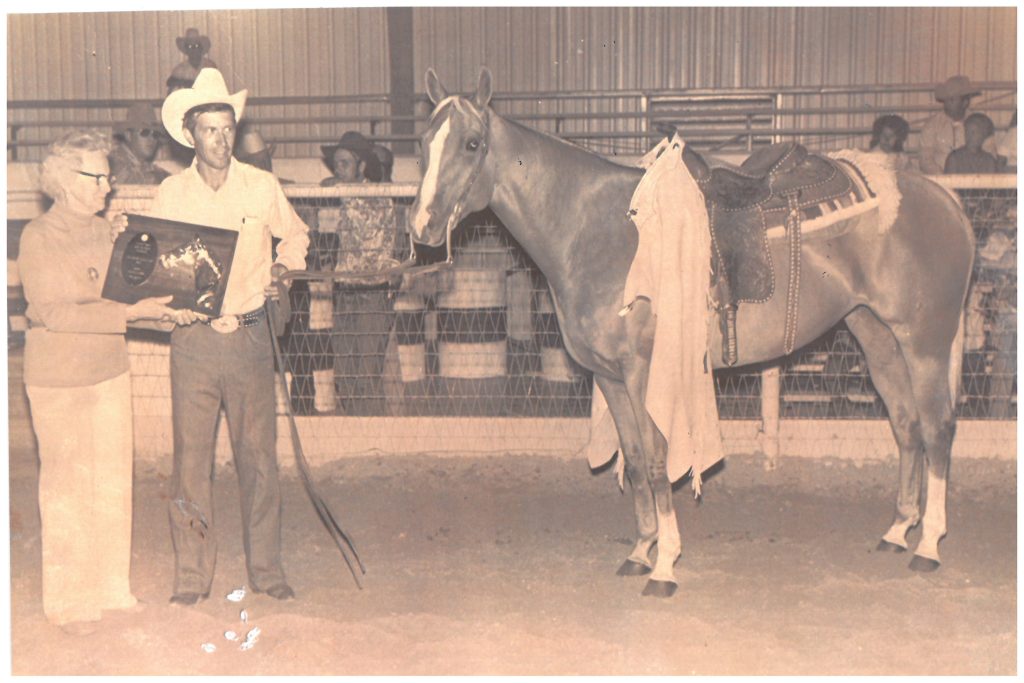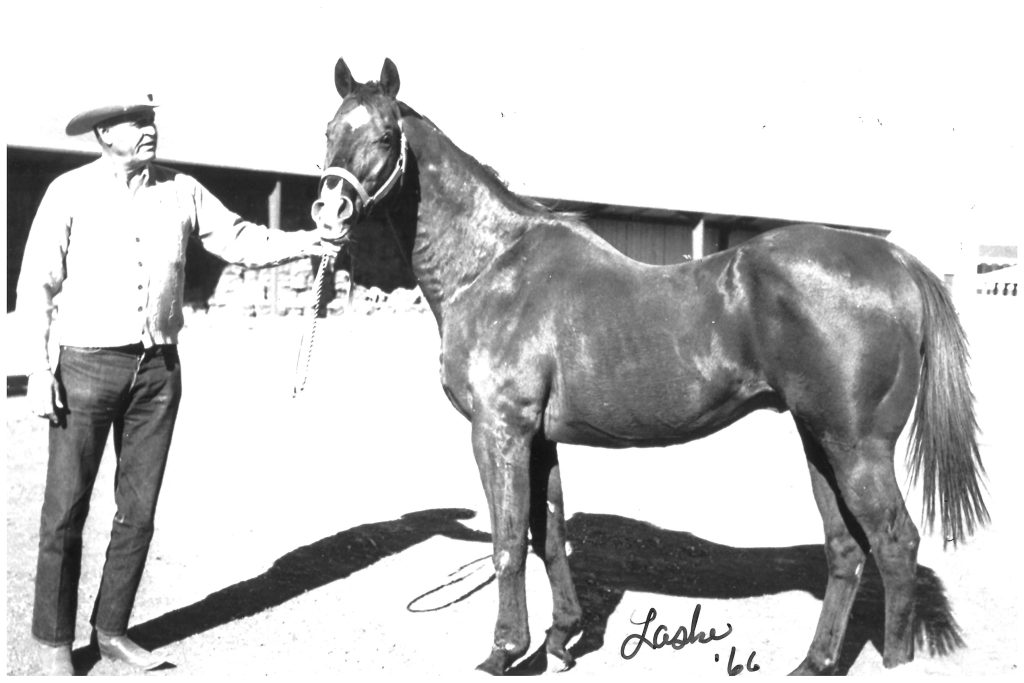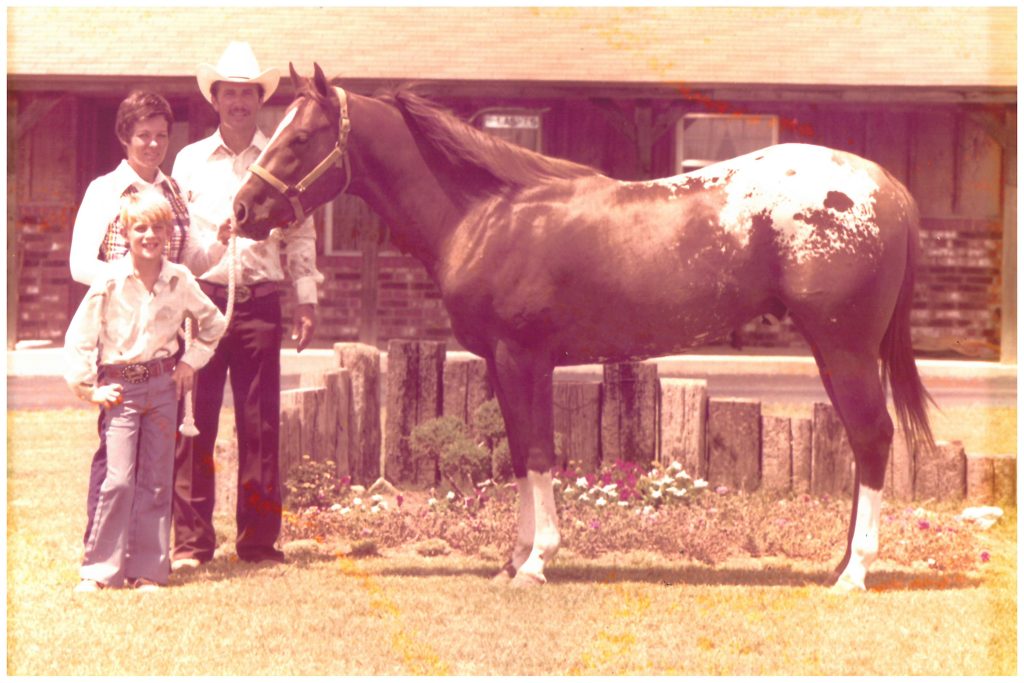Part 2: How the Pioneer Horse Breeders Affected Current Breed Standards
Pioneer Horse Breeders is a book by Ed Roberts, Frank Holmes, Carol Plybon and Randy Witte, much of the information in this article can be found with more depth in the book. This series of articles contains notes from retired Palomino, Paint and Appaloosa judge Wayne Laske in italics. Find Part 1 by clicking here if you missed it.
Pioneer Breeder Marshall PeavyMarshall Peavy was born in 1889 in Alabama the family moved to Routt County. They acquired several thousand acres in Deep Creek so young Marshall could pursue his love of ranching and horses. He soon found horse racing as his favorite event.
Marshall was in the right place to excel in ranching and horse breeding. In 1916 he bought his first great stallion Bob H (Old Fred x Queen Litze (TB) x Likely (TB)) from Si Dawson. He also bought a set of Primera mares. His breeding program was in place with many mares being daughters of Peter Mccue or Anson horses. This combination had a big influence on both the AQHA and the Appaloosa Horse Club (ApHC) breeds.
In 1924 Marshall bought a young stallion named Shiek from Coke Roberds. He was by Peter Mccue and out of an Old Fred mare. He was considered an AQHA foundation horse and given registration #11.
Perhaps the horse the Peavys owned that had the greatest impact on several breeds was the palomino Gold Heels. He was a halter horse and was Grand Champion Stallion at the first Denver National Livestock Show.
I can attest to the quality of the Gold Heels horses. I judged the Colorado State Fair in 1964 when Mildred Janowitz from Castle Rock showed the great palomino mare Better Be Sweet (Sucaryl x Tempest Storm x Hons Stormy Gold). She won her halter class, won the color class, and first in reining.
When I got home from the show my friend Gary Little of Ardmore called and said he would like me to find a nice horse to show, and we would be partners. I went right to The Quarter Horse Journal and found Better Be Sweet was for sale. A quick phone call, and the purchase of the mare was complete. I took her to the Ft. Worth Livestock Show and won her class, won the color class, won the reining and placed in the western pleasure class. We did the same thing at the Houston Livestock Show. At the end of the year she was the high-point all-around palomino, having gone to only half as many shows as the second place horse. After sweeping the stock shows we sold her to a man in Indiana for $19,500 around 1975.
 Better Be Sweet as a four-year-old at the New Mexico state fair. She was out of the double bred granddaughter of Gold Heels, Tempest Storm. * Photo courtesy of Wayne Laske
Better Be Sweet as a four-year-old at the New Mexico state fair. She was out of the double bred granddaughter of Gold Heels, Tempest Storm. * Photo courtesy of Wayne Laske
Marshall and Mavis Peavy caught the attention of Lane Hudson of Denver and later Castle Rock. Lane had raised the great stallion Mighty Bright (Bright Eyes Brother (AP) x Peggys Delight (QH) x Red Dog (QH)).
Lane HudsonI got to meet Lane in a waiting area for a flight to Bismarck. He walked over to me and asked if I smoked, which I didn’t. He said, “I want to sit by you.” While with the Quarter Horse Journal I was working the ring at a lot of sales and Lane was traveling for Western Horseman. That was over 55 years ago, and we remained good friends until his death a few years ago.
Lane was a small breeder and was not opposed to taking a chance on getting color when breeding to Quarter Horse or Thoroughbred stallions. One example was Mr. Big Wig, Lane raised Big Wig when he bred his mare Bright Delight, a sister to Mighty Bright, to Wiggy Bar (Three Bars (TB) x Piggy Wiggy (QH) x Piggin String (TB)).
 Walter Merrick and Three Bars (26 years-old) at Quanah, Texas. Though bred mainly to quarter mares he did breed paint and appaloosa mares as well. His last foals were born in 1968. * Photo courtesy of Wayne Laske.
Walter Merrick and Three Bars (26 years-old) at Quanah, Texas. Though bred mainly to quarter mares he did breed paint and appaloosa mares as well. His last foals were born in 1968. * Photo courtesy of Wayne Laske.
I was at Lane’s one day when Mr. Big Wig was running at Pueblo so we went there, picked him up and took him to an Appaloosa show where he stood grand and then took him back to the track. Lane was very generous with giving out a breeding to any horse he owned if he thought your mare would fit well with one of his stallions. I had just bought Vanna Bright (Bright Bar x Vanna Mio x Vandy) at a sale in Lexington, Oklahoma. Lane offered me a free breeding to Mr. Big Wig, and it didn’t take long to accept the offer.
Dee Garrett from Pawhuska, Oklahoma, owned Vandy and traded five breedings to Bright Bar. When she foaled, I took her to Mr. Big Wig, and in the spring she had a loud colored colt named Old Pappy in honor of Lane. I took Old Pappy to Louie Wartchow in Ada, Oklahoma, who trained him and won at the track. I sold him to a man in Connecticut for a show horse. His disposition was beyond belief.
 Old Pappy as a two year-old right off the track. * Photo Courtesy of Wayne Laske
Old Blue Mare
Old Pappy as a two year-old right off the track. * Photo Courtesy of Wayne Laske
Old Blue Mare
Perhaps one of the more influential mares bred by the pioneer horse breeders that was never registered was referred to only as Old Blue Mare. She was foaled in the early 1900’s on the western slope of the Rockies.
It was Marshall Peavy who was responsible for Old Blue when he bred Bob H to a roan Roberds mare. The foal was described by Peavy as a little grayish-blue filly known as Blue Mare.
She was foaled in 1918 in a snowbank. Consequently, she never got too big. Due to her size she was never saddled but went to work raising foals. Some of the foals out Old Blue Mare were registered with the ApHC and others with less roan coloring registered with the AQHA. Her first foal by Bob H was Papoose. Papoose was quite large but had speed.
Papoose started raising foals when she was nine. When bred to Ding Bob she had three great foals: Sue Peavy, a bay; Margie, a sorrel; and Chipeta, of marginal color (later photos show her a loud colored Appaloosa).
In 1941 Peavy gave Papoose to Jack Casement when she was 18 years old. Casement bred her to Red Dog and got Cherokee Maiden and Baboon, a loud colored Appaloosa that was gelded and made a great racehorse.
Cherokee Maiden was born solid colored and registered with the AQHA. She was a halter winner and received the reserve champion mare at the 1944 National Western Stock Show. Her real fame came as the mother of two great foals, Alfaretta (by Robin Reed) and Red Wig (by Wiggy Bar), who both achieved titles of AAA AQHA Champions. Cherokee Maiden was also the granddam of Little Chloe, the 1962 champion Quarter running two-year-old.
Pioneer Horse Breeders Jack and Dan CasementAnother successful horseman joined the fraternity of pioneer horse breeders. Jack Casement and Marshall Peavy were not only friends but also successful breeders. The Casements were located just north of Steamboat Springs on an irrigated ranch by the Elk River in 1941. A short time later Casements moved to Routt County, the hot bed of pioneer breeders.
Jack and a few select others were selected and charged with being registry inspectors for the AQHA. These pioneer horse breeders were also instrumental in the forming of the AQHA.
Jack’s brother Dan bought Concho Colonel (Jim Ned 2 x Anson Mare) and used him to breed his band of 11 mares. Jack continued his breeding by picking mares to breed to Balleymooney, a son of Concho Colonel. Those mares were sired by Springers Little Joe, thus infusing some new breeding. Joe’s last foal crop was in 1933, and Balleymoney died that winter. Five of the foals were colts: Red Dog, Frosty, Deuce, Billy Byrne, and Buckshot.
Wisely, Jack picked Red Dog as his top stallion, and Dan took Deuce. Jack took Red Dog to northeastern Colorado where he was later killed by lightning.
Not to overlook the Casement influence, but several references have been previously mentioned how they influenced other breeders. Jack’s success on the track was enviable. Consider the success with Little Meow (Tadpole x Jackie McCue x Jack McCue), a granddaughter of Red Dog. She was not a large horse, but very few could touch her in a race. After her race career she was bred to Roy Barnes’ stallion Robin Reed (Leo x Sue Reed x Joe Reed). The resulting foal was just as great as Little Meow when She Kitty was born. Not only could Casement’s horses run, but they had wonderful conformation.
Robin Reed was a highly successful racehorse and possessed outstanding conformation. He crossed on Thoroughbred mares and still produced conformation as evidenced by Net Profit and Capital Gain, out of a daughter of Custus Rastus (TB).
I bought Revenue Reed, one of this last foals, that was bred by Lewis Blackwell of Amarillo. I was looking for a modern horse with conformation and found Revenue Reed and bought him as a long yearling from C. E. Boyd at Sweetwater, Texas. C.E. was famous as the owner of King Glo, his foals were shown by Buster Welch. Revenue Reed was only a two-year-old when I won the big spring shows in Minnesota. Frank Autry had leased Robin Reed and came to Minnesota to do a clinic and looked at my stud and asked if he was by Robin Reed. He said my horse looked just like his daddy.
I have found the book Pioneer Horse Breeders to be very fascinating because I love Studying pedigrees. Additionally, I bought my first Quarter Horse when the breed was barely 10 years old. While working for The Quarter Horse Journal I flew to horse sales and saw a lot of this breeding at the sales, especially in and around Colorado.
Having spent a lot of time with Lane Hudson was also a real treat because he shared so much about the Maddon’s Bright Eyes and Peavy horses. He was a serious student of breeding and contributed immeasurably to the improvement of the Appaloosa industry both from the standpoint of conformation and racing disciplines.
Mashups and APIs
- Home
- About Us
- Write For Us / Submit Content
- Advertising And Affiliates
- Feeds And Syndication
- Contact Us
- Login
- Privacy
All Rights Reserved. Copyright , Central Coast Communications, Inc.